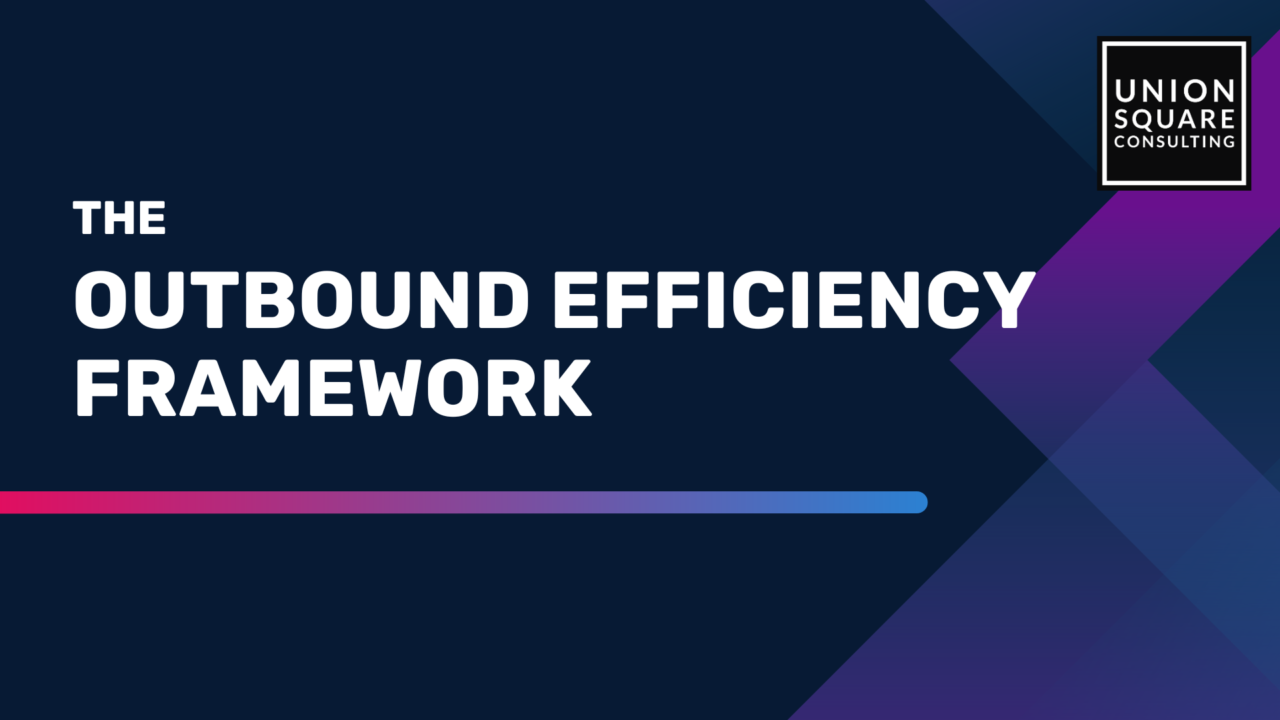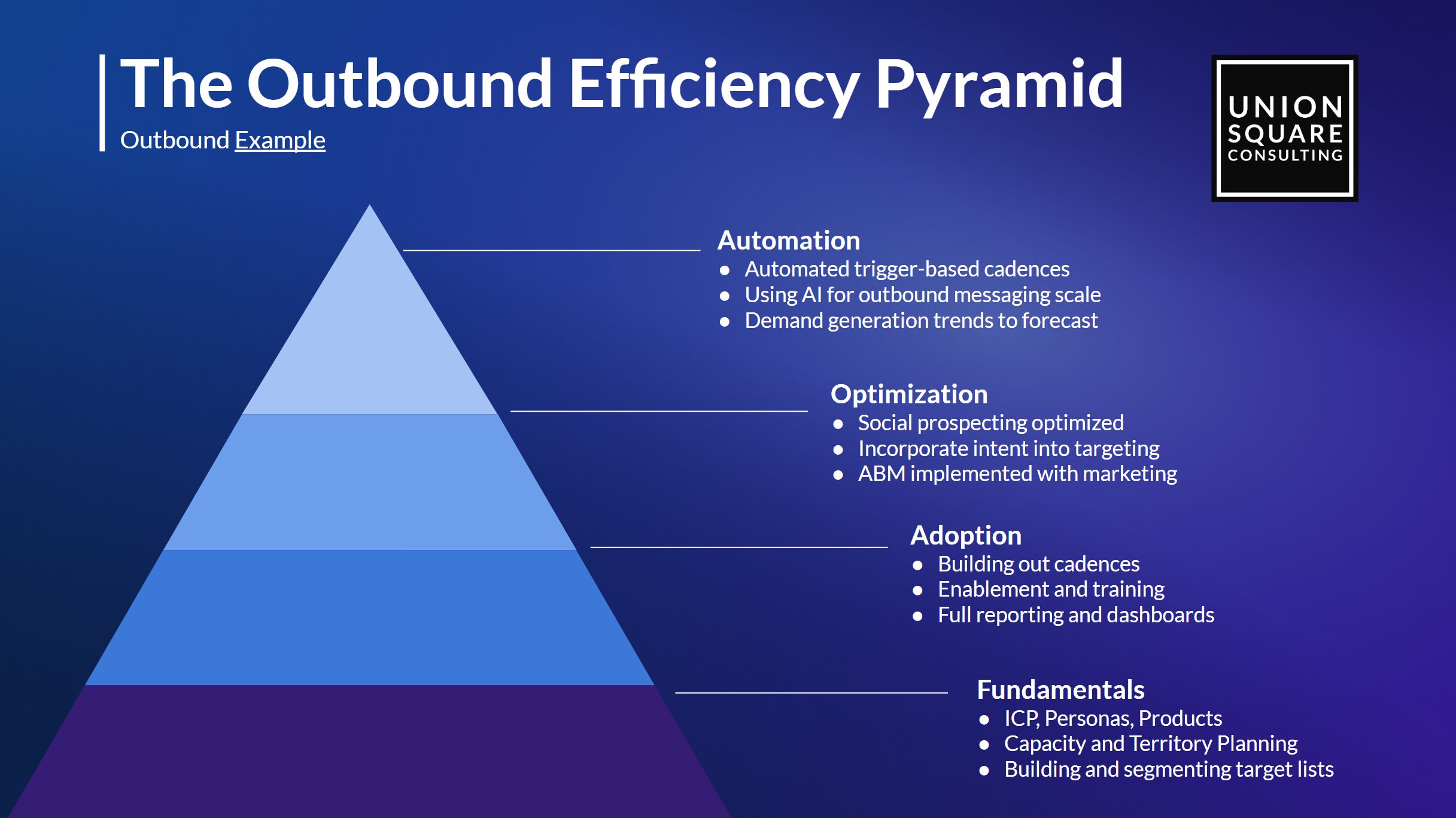
The Outbound Efficiency Framework
Read time: 10 minutesDownload Infographic: Click here to download high-res PDF
Download Full Guide to Modern Outbound: Click here to download high-res PDF
Is Outbound Dead?
It now takes 1,000 to 1,400 activities to create a single opportunity, on average. Many outbound teams are struggling to produce any meaningful revenue at all. This is unsustainable – but it can be fixed. This happens for one simple reason: Reps are targeting the wrong people in the wrong companies with generic, irrelevant, ineffective messaging.
On the flip side, research shows that personalized outreach can convert 7% of target accounts to meetings. We have a number of clients doing this and see these same numbers in our own cold outreach at USC.
So, outbound isn’t dead. Some of its common practices are, though. Spray and Pray is dead. Loading tens of thousands of random prospects into a cadence tool and pressing “Send All” on generic messaging is dead. Casting a wide net, trying to be everything to everyone is dead.
Outbound works when reps get the right messaging to the right buyers. It works when outbound teams have an efficient system to produce quality outreach with enough quantity to hit targets.
In this Framework, we will break down the components of an efficient, modern outbound system that will produce far more revenue with the same team and the same level of effort.
******************************************************************
FUNDAMENTALS
To build an effective Outbound Engine we need to start with the Fundamentals, the basic components needed for reps to reach the right buyers with the right messaging efficiently and effectively. Here are those Fundamentals.
ICP, Buyer Personas, and Products
Our Ideal Client Profile(s) and Buyer Personas define who is most likely to buy, easiest to sell, and who spends the most. By pure definition, anyone we prospect that isn’t in our ICP and Buyer Personas will be a poor use of time. So, we need to carefully define this – and if we have multiple products, we need to define our product set and the ICP/Personas for each product.
This will drive everything else we do in our GTM. Most companies don’t go far enough here though. They define ICP as an entire industry or set of industries and/or a wide revenue band. This yields tens or hundreds of thousands of target accounts, 100X what our salespeople can cover. By definition, they will NOT be targeting the absolute best accounts.
Instead, we need to carefully look at our existing clients and every data point we can access to define ICP as narrowly as possible. Ideally narrow down to the capacity our team has to work that list.
Capacity and Territory Planning
Imagine your best sales rep, your rainmaker. You give her the best 2,000 accounts.
She can’t cover all of them, though, so you have a number of problems:
- She’s not calling the best accounts in her territory
- Some of your best accounts aren’t being called at all
- She’s doing data analysis, instead of selling, to identify prospects
Is your best sales rep also your best data analyst? Is this where you want her spending her time?
Instead, we can do a Capacity Plan and figure out exactly how many accounts and contacts she can cover this year. Then we can identify the absolute best prospects within that number so she is laser focused on the prospects most likely to convert and close. We make her life easier and generate more revenue.
Building and Segmenting Target Lists
Now imagine our all-star sales rep is prospecting this morning. She calls the CFO in a B2B SaaS company first. Then she calls a VP of Sales in a manufacturing company next. Then she’s on to the CEO of a healthcare company. She’s a rockstar, so each message she leaves is a 10/10. But how easy was it?
What if, instead, she spent the entire day/week/month just prospecting into CFOs in B2B SaaS companies that were PE-backed and had $100M to $200M in revenue? How much better would her massaging be after the 5th contact? After the 50th? The 500th? How much faster would she work through the list while maintaining 10/10 messaging?
By segmenting our target lists, as narrowly as a single Buyer Persona in one industry/type of company, our salespeople can work more efficiently and effectively. Just imagine what this does for our normal reps, our struggling reps, our new reps still onboarding.
- Newsletter #46 – The Sales Nurture Playbook
- Newsletter #40 – Operationalizing Outbound Part 2: Building the List
- Newsletter #39 – Operationalizing Outbound Part 1: Capacity Planning
- Newsletter #37 – Creating a Territory Management Plan
- RevOps Live #19 – Building Better Territories
- More on this topic in upcoming newsletters – subscribe here to get it in your inbox
******************************************************************
ADOPTION
With the Fundamentals in place, we need to drive Adoption of the outbound process across our team. Here is how we do this.
Building Out Cadences
What’s the step-by-step process to prospect target lists in each segment and when do reps walk away?
We answer that by building out cadences and arming reps with clear steps and an efficient workflow. When do reps personalize emails and when do they use templates that are highly relevant for each segment? What data and information do reps need to research accounts and contacts before reaching out?
One major gap we see often is data enrichment. Reps aren’t armed with enough information so they burn valuable selling time finding websites and social profiles, toggling systems to review past interactions with sales and marketing, etc or they simply skip this step and send out generic messaging.
The right cadences and outbound process can make reps more efficient and effective at the same time.
Enablement and Training
The processes and systems we build are only as good as our execution. Once we have them in place we need to train the team and drive adoption. Training isn’t a one-time exercise though. We need to reinforce training on an ongoing basis, by monitoring reporting and reminding reps of the best process to execute outbound.
Full Reporting and Dashboards
Driving adoption, and also results, relies on solid reporting. How much pipeline is each rep generating? How many meetings are they booking and what does activity look like? What are conversion rates from activities to meetings to pipeline?
With the right reporting in place, we can see which reps are executing and which aren’t. We can see what’s working and what’s not working with each rep and across the entire team. This dramatically improves coaching and also our ability to optimize the outbound process.
- Newsletter #72 – How to Drive Real Revenue Through Salesforce
- Newsletter #71 – Data Driven Sales Coaching
- Newsletter #61 – Most GTM Reporting is Useless
- Newsletter #41 – Operationalizing Outbound Part 3: Creating Your Sequences
- More on this topic in upcoming newsletters – subscribe here to get it in your inbox
******************************************************************
OPTIMIZATION
With Fundamentals and Adoption, we now have the foundation in place to get our team executing the basics of outbound. From here we can start to measure what’s working and what’s not and optimize the outbound motion. There are numerous ways to do this. Here are just a few examples.
Outbound Insights
Our reporting gives us insights into what’s working and what’s not working. We can leverage those insights to identify ways to optimize outbound. To do this, we need to slice and dice the data to see which reps are generating the most pipeline and, ultimately, revenue. We look at different company segments, different buyer personas, messaging, activity levels. etc. to identify trends.
This then enables us to double down on what’s working and help our team narrow their focus to where we’re seeing the most success.
Pipeline Council Meetings
The insights we’ve uncovered require us to take action. If we have a large revenue team, it can make sense to pull in heads of sales, marketing, customer success, product, and/or finance to discuss what’s working to generate and close pipeline and what we should do differently.
ABM Implemented with Marketing
For most companies, a very small percentage of “inbound leads” are from people that request a meeting with sales. The other 99.9% require the same efforts as cold outbound prospects to convert to a meeting, pipeline, and revenue.
As our outbound motion evolves, we should combine these two sets of companies and contacts in our ICP and simply rank or score them by priority and prospect into them in one unified motion. This, by definition, means we’re investing resources in the most likely prospects to convert and eliminating the inefficiencies of having two teams doing virtually the same thing in silos.
- Framework – The GTM Metrics and Insights Framework
- Framework – The Pipeline Management Framework
- Newsletter #62 – How to Conduct Pipeline Reviews Like Salesforce
- Newsletter #60 – Most Of Us Are Doing Account Scoring Wrong
- Newsletter #56 – Create Strategic Alignment with a Pipeline Council
- Newsletter #53 – What Does Account Based Really Mean
- Podcast – Create Strategic Alignment with a Pipeline Council
- Podcast – How to Launch ABM with Andrei Zinkevich
- More on this topic in upcoming newsletters – subscribe here to get it in your inbox
******************************************************************
AUTOMATION
Finally we get to the shiny objects that excite us all – automation, AI, and other advanced scaling concepts. This is often where we want to start, but there’s no bigger waste of money than automating a broken process.
However, with the Fundamentals, Adoption, and Optimization in place, we should have something working. We should see our reps booking meetings and converting them to pipeline and revenue. Now, we can ask ourselves how to do this better and faster using some of the exciting tech tools that are constantly being innovated. Here are just a couple examples among hundreds of options.
Automated Trigger-Based Cadences: Work Smarter, Not Harder
With the above foundation in place we’re chasing the right people in the right companies with the right messaging. But are we doing it at the right time? Triggers are any signals that indicate the timing might be right now.
Great salespeople spend a lot of time and effort searching for and tracking triggers. By automating trigger-based cadences we can take this heavy lift off their plates and help them work much smarter, targeting the right people at the right time with minimal effort.
Using AI to Scale Outbound Messaging: Personalization at Speed
Finally we get to the shiniest object of the moment, AI personalization. Most of us have already received hundreds of mediocre AI-generated sales emails. That’s precisely why we saved this for last.
Once we have the process above in place, we can feed the AI the right people in the right companies at the right time with the right data and generate personalized messaging that actually resonates with our audience. These emails often still need a little personal touch but AI can help us work better faster, if, and only if, we have the right foundation in place.
- Newsletter #49 – Sales Triggers with John Barrows
- Newsletter #41 – Operationalizing Outbound Part 3: Creating Your Sequences
- Podcast – Optimizing the Outbound Process with John Barrows
- More on this topic in upcoming newsletters – subscribe here to get it in your inbox
When you’re ready, here’s how we can help:
Get a Free 1:1 Revenue Efficiency Workshop
Get one of our Senior Revenue Strategists to yourself for 1 hour and leave with a plan to increase the money-making power of your go-to-market operations.
Hire Us!
Bring us on as your Strategic RevOps Team and realize the growth potential of your revenue engine. There are 3 ways to work with us.